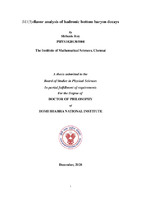- DSpace Home
- →
- IMSc Theses/ Dissertations
- →
- IMSc Theses/ Dissertations
- →
- View Item
JavaScript is disabled for your browser. Some features of this site may not work without it.
| dc.contributor.author | Shibasis Roy | |
| dc.date.accessioned | 2021-10-13T11:52:26Z | |
| dc.date.available | 2021-10-13T11:52:26Z | |
| dc.date.issued | 2021 | |
| dc.date.submitted | 2021 | |
| dc.identifier.uri | https://dspace.imsc.res.in/xmlui/handle/123456789/569 | |
| dc.description.abstract | SU (3)-flavor symmetry is the symmetry of three light quarks namely the up, down and strange quarks. Although it is an approximate symmetry of the Standard Model, this symmetry is very useful to study weak decays of hadrons. A decomposition of decay amplitudes in terms of SU (3)-flavor requires one to first identify the SU (3)-flavor states of the initial state, final state and an interaction Hamiltonian that connects the initial state to the final state. In the SM, the interaction Hamiltonian is the dimension-6 weak Hamiltonian consisting of four-quark operators having one or more SU (3)-flavor representations. In case of a two body final state, the final state SU (3)-flavor representation is the product state of the two hadrons. The upshot of this procedure is to be able to write the decay amplitudes in terms of reduced matrix elements of explicit SU (3) operators with appropriate coefficients. Since these SU (3)-reduced amplitudes are process independent, all possible decays mediated by the same effective Hamiltonian can be parameterized in terms of those few reduced amplitudes. In the thesis, this technique is applied to two body charmless weak hadronic decays of bottom baryons. The final state hadrons are octet or decuplet light baryons and octet or singlet pseudoscalar mesons whereas the initial state is an anti-triplet bottom baryon under SU (3)-flavor. Rather than starting from a given form of effective Hamiltonian, the most general effective Hamiltonian that can mediate such a transition is used as a starting point. Finally, the dimension-6 weak Hamiltonian is assumed and the set of SU (3)-invariant amplitudes are found. As expected, the number of independent SU (3)-invariant amplitudes are much lower than the total number of accessible decay modes. As a result, decay modes get related to each other and a number of amplitude relations between them is found. Some of these amplitude relations can be translated into relations between decay rates and CP asymmetries as well. These relations are very interesting as these can be verified in the LHCb experiment in near future. With adequate number of experimental measurements of different decay modes, it may be also possible to numerically estimate these SU (3)-invariant amplitudes by directly fitting them to the data. Since these invariant amplitudes can be mapped to quantities that can be calculated using a various theoretical approaches, the fit values can also be compared with the theoretical predictions. | en_US |
| dc.publisher.publisher | The Institute of Mathematical Sciences | |
| dc.subject | SU (3)-flavor analysis | en_US |
| dc.subject | HBNI Th193 | en_US |
| dc.title | SU(3)-flavor analysis of hadronic bottom baryon decays [HBNI Th193] | en_US |
| dc.type.degree | Ph.D | en_US |
| dc.type.institution | HBNI | en_US |
| dc.description.advisor | Rahul Sinha | |
| dc.description.pages | 126p. | en_US |
| dc.type.mainsub | Physics | en_US |
| dc.type.hbnibos | Physical Sciences |
Files in this item
This item appears in the following Collection(s)
-
IMSc Theses/ Dissertations
IMSc Theses/ Dissertations
